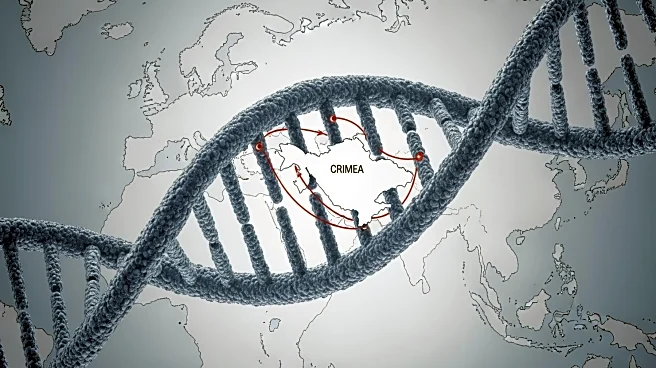What's Happening?
Researchers have uncovered new DNA evidence from the Starosele archaeological site on the Crimean Peninsula, shedding light on Neanderthal migration patterns from Europe into Asia. The study, published
in the Proceedings of the National Academy of Sciences, utilized collagen peptide mass fingerprinting, also known as Zooarchaeology by Mass Spectrometry (ZooMS), to identify a Neanderthal individual from bone fragments. Radiocarbon dating places these fragments at approximately 45,910 to 45,340 years ago. The analysis revealed that 93% of the bone fragments were horse remains, indicating that Neanderthals primarily hunted and consumed horses. The study also used mitochondrial DNA sequencing to confirm the Neanderthal lineage and found genetic links to other Neanderthal populations in the Altai region of Russian Siberia.
Why It's Important?
This discovery is significant as it provides a clearer understanding of Neanderthal migration routes and their interactions across vast distances. The genetic links between the Crimean Neanderthals and those in Siberia suggest long-distance connections and cultural exchanges. This evidence contributes to the broader narrative of human evolution and migration, offering insights into how early human species adapted to different environments. The findings also highlight the advanced hunting strategies of Neanderthals, as evidenced by their reliance on horse hunting. This research could influence future studies on human ancestry and the movement of ancient populations across continents.
What's Next?
Future research may focus on further exploring the migration corridors identified through habitat suitability modeling, which used paleoclimate data to reconstruct potential routes between Crimea and the Altai region. These studies could provide more detailed insights into the environmental conditions that facilitated Neanderthal movement. Additionally, researchers may continue to search for more DNA evidence to strengthen the understanding of Neanderthal migration and their interactions with other hominin species. The ongoing analysis of archaeological sites in these regions could uncover more artifacts and genetic material, offering a more comprehensive picture of Neanderthal life and migration.
Beyond the Headlines
The study raises questions about the cultural and technological exchanges that may have occurred between Neanderthal populations across Europe and Asia. The similarities in tool construction found at the Crimean site and those in the Altai region suggest a shared knowledge or influence, which could have implications for understanding the spread of technology and culture among early human species. This research also underscores the importance of interdisciplinary approaches, combining archaeology, genetics, and climate science, to unravel the complexities of human history.













